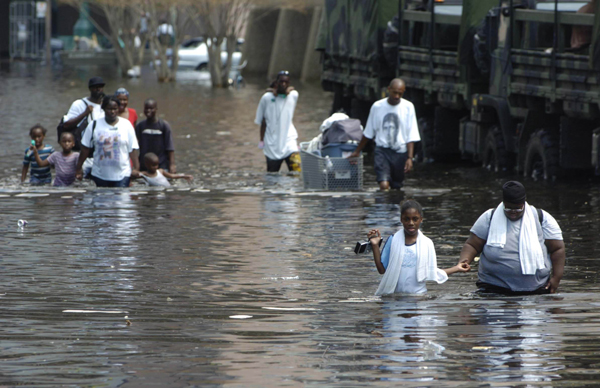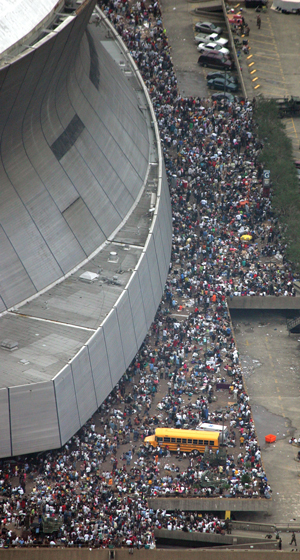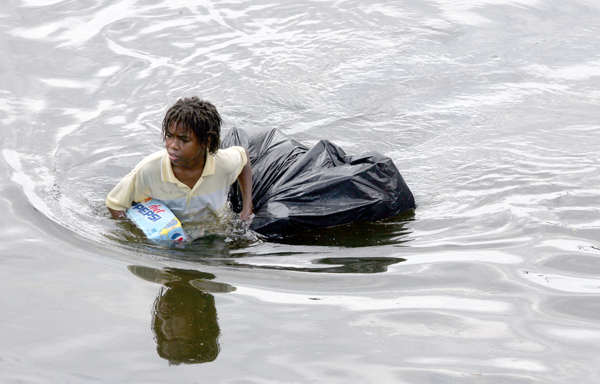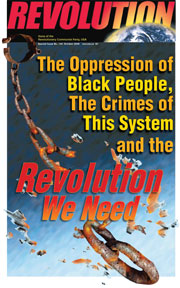Hurricane Katrina & the Crimes of a Genocidal System
August 24, 2015 | Revolution Newspaper | revcom.us

It is ten years since Hurricane Katrina hit New Orleans and the Gulf coast—the true story of Katrina reveals the utterly worthless nature of this system and why and how things do not have to be like this. Above: People in New Orleans who were abandoned by the system carry their possessions through the flooded streets, August 31, 2005. (AP photo)

 Up to 20,000 people were subjected to slave ship conditions at the Superdome and Convention Center. People were herded in and locked up to wait to be evacuated, treated -- not like victims who had just experienced a horrible natural disaster, with many not even knowing the fate of other family members—but like prisoners and animals, subjected to the most inhumane, unsanitary conditions, having to face National Guard troops with assault rifles, ready to shoot.
Up to 20,000 people were subjected to slave ship conditions at the Superdome and Convention Center. People were herded in and locked up to wait to be evacuated, treated -- not like victims who had just experienced a horrible natural disaster, with many not even knowing the fate of other family members—but like prisoners and animals, subjected to the most inhumane, unsanitary conditions, having to face National Guard troops with assault rifles, ready to shoot.
Above: a SWAT team drives past flood victims waiting at the Convention Center in New Orleans, Thursday, Sept. 1, 2005. Right: people herded into a virtual concentration camp at the Superdome. (AP photos)
On August 29, 2005, Hurricane Katrina hit the city of New Orleans. This was one of the five deadliest hurricanes in the history of the United States. But what followed was far worse.
Hurricane Katrina was a ferocious storm. It brought terrible destruction to the Gulf Coast from central Florida to Texas. The greatest destruction, suffering, and death occurred in New Orleans. The suffering was not, overwhelmingly, a result of the storm itself. The problem was that levees that were supposed to hold back the sea in New Orleans had essentially been abandoned by the government and were no match for the storm surge that followed the hurricane. 1,833 people on the Gulf Coast died as a result of the storm and its aftermath. In New Orleans, 134,000 housing units—70 percent of the total—were damaged.
In the richest country on the planet, survivors—overwhelmingly Black and poor—were left to die. Bodies floated in the water for days and weeks. Thousands of Black people were locked down in the New Orleans Superdome in conditions reminiscent of slave ships. In the richest country in the world, abandoned New Orleans looked like an impoverished Third World country.
The sight of people standing on their floodwater-surrounded roofs with signs demanding “Help Us!” and not getting help... the way the system branded those who were distributing desperately needed food and water as “looters”... the military occupation and violent repression unleashed against the survivors... all this shocked and outraged millions. It exposed the ugly, utter worthlessness of this system.
Abandoned by the government, people took heroic risks, against all odds, to rescue and look out for each other. Those who the government vilified and attacked as “looters” kept people alive, distributing food and water the government would not provide. Millions around the country saw the government was leaving people to die, expressed their outrage, and tried to help. That outrage, and that desire to help, gives a sense of the potential for a whole different kind of society than one based on a mad scramble for profit.
In the 10 years since Katrina, images of the horrors brought on in part by a natural disaster, but much more profoundly by a disastrous system, have faded. But we cannot allow the truth of what happened, what was done to people, to be swept under the rug. We can’t allow that because it was a historic crime. We can’t allow it because the true story of Katrina reveals the utterly worthless nature of this system. And because the true story of Katrina sheds light on why, and how, things do not have to be like this.
****
Abandoned to Die
Days before Katrina hit New Orleans, meteorologists predicted a very serious hurricane, saying the city, which is six feet below sea level, should be evacuated. But the government did nothing to evacuate the city, stranding close to 100,000 of poor and Black people they knew might well die in a place that was going to get clobbered by the storm.
As the levees collapsed, floodwaters rose 20 feet in parts of New Orleans, and 80 percent of the city was unnecessarily under water. In a country with the technology to build nuclear bombs, maintaining levees that protected the city rated a zero on the rulers’ lists of priorities.
And when the flood submerged the city, there was no help for tens of thousands of desperate people stuck for days on the roofs of houses in 100-degree heat with nothing to eat or drink. Bodies of poor and Black people were left floating in water, on sidewalks, underneath debris, decomposing, mangled. Left for days, left for months.
Volunteers who headed for New Orleans, especially in the immediate aftermath, were turned away by the military—in one case school buses sent to evacuate survivors were commandeered by the police.
On September 1 a group of people tried to get to safety by crossing a bridge into Jefferson Parish and police lined up with shotguns and wouldn’t let them cross. On September 4, James Brissette and Ronald Madison were among others walking across the bridge to get food at a grocery store when they were shot and murdered by the police. Ten years later, the murderers are free. (Convictions of five of the police who carried out these murders were overturned in 2013.)
In a society profoundly defined by the mass incarceration of millions, 7,000 prisoners—yes, again, mostly poor and Black—were left to the mercies of the flood. Water flooded the prisons. Power went out, plunging people into total darkness and shutting down the electrical system used to open cell doors. For days, prisoners were trapped with no food, water or needed medication and had to resort to drinking contaminated floodwater containing raw sewage. Prisoners said deputy snipers shot at anyone who tried to get out of the flooded, suffocating buildings. When deputies came back into the prison building, they didn’t come with food, water, or any other kind of help. Instead they came with riot gear, shotguns, mace, batons, Tasers, and brutality, and prisoners were evacuated under inhuman and brutal conditions.
The president and other federal officials—who sit atop a system that taps the phones and tracks nearly everyone on the planet—managed to remain blind, deaf, and dumb to all the suffering and horror. In the midst of the hell people were being subjected to, President George W. Bush slapped the back of the head of FEMA (Federal Emergency Management Agency) and said “[Y]ou’re doing a heckuva job.”
Locked Down in the Superdome
More than 20,000 people were herded to and locked up at the Superdome to wait to be evacuated, treated, not like victims who had just experienced a horrible natural disaster, with many not even knowing the fate of other family members, but like prisoners and animals, subjected to inhumane, unsanitary conditions, having to face National Guard troops with assault rifles. People suffered from dehydration and were surrounded by disease-ridden water.
This was not because there was no water. When Green Party activists tried to distribute clean water to people locked down in the Superdome, armed soldiers pointed rifles at them and prevented them from delivering supplies. Even Walmart trucks loaded with drinking water were turned away.
Dead bodies were left out in the open. Many said they felt like they were in a concentration camp. One man who had spent time in the Orleans Parish Prison told the New York Times, “It’s worse than a prison. In prison, you have a place to urinate, a place for other bathroom needs. Here you get no water, no toilets, no lights.”
The floors of the stadium were soaked with rainwater, part of the roof had collapsed, people were subjected to the stench of overflowing toilets and had to relieve themselves in hallways and stairwells. Feces and garbage were everywhere. People had no access to any kind of real medical care or needed medications. There were no showers and people were given no clean clothes. There was very little food, water, blankets, or sheets.
Ethnic Cleansing of New Orleans
When the government finally evacuated people from New Orleans, they did it like modern day slave owners, with tens of thousands scattered all over the country, with one-way tickets to 44 different states. A resident recalled: “With the evacuation scattering my family all over the United States, I felt like it was an ancient memory, as if we had been up on an auction block.” More than a few people talked about how this echoed families being separated during slavery.
People put on buses didn’t know where they were going. Families were separated, children ripped away from their parents. People were treated like criminals or potential criminals. Background checks were done when people checked into shelters. Some were jailed on old warrants; some immigrants were deported. People were housed in heavily guarded centers with metal detectors, surrounded by police cars, armed soldiers, FEMA agents, and federal, state, and local officials.
Later, as the waters receded, efforts to rebuild the devastated, mostly Black sections of the city were stymied and stopped by policies of ethnic cleansing. Public housing, home to poor and Black people, was bulldozed even when it was perfectly sound and could have been cleaned up and repaired. Louisiana Congressman Richard Baker said, “We finally cleaned up public housing in New Orleans. We couldn’t do it, but God did it.” And Secretary of Housing and Urban Development Alphonso Jackson declared, “New Orleans is not going to be as Black as it was for a long time, if ever again.”
A System of Global Plunder and Terror Attacks Black People as “Looters”

Bottles of water are handed over a fence to Hurricane Katrina victims at a temporary hospital set up at the New Orleans airport, September 3, 2005. (AP photo)

People unable to evacuate New Orleans were forced into the Louisiana Superdome and the Convention Center (above) where they were treated like criminals and slaves. Meanwhile, others (below) risked their lives to take food and supplies from abandoned stores to help save the lives of others. They were criminalized by the authorities and media as “looters.” (AP photos)

Young people stuck in New Orleans—who before the crisis might have been engaged in a dog-eat-dog struggle to survive—set aside blood feuds. They worked together to the best of their ability—liberating food, water, and medicine, and distributing those essential supplies to people in desperate need.
Here, and in other ways, you got a glimpse of why things don’t need to be this way. You saw people rise above a lot of the bullshit they are caught up in, go up against the powers-that-be, and put serving the people ahead of the dog-eat-dog mentality of capitalism.
To the rulers of this capitalist system, this was utterly intolerable. Their mass (better put, ruling class) media vilified these heroes as “looters.” And their military—their whole “national security” apparatus—demonstrated that the essence of “national security” is the security of the class of parasitic oppressors who rule this country.
The commander of the Louisiana National Guard’s Joint Task Force said: “This place is going to look like Little Somalia.” He was referring to the 1993 U.S. invasion of that impoverished and plundered African country. U.S. troops terrorized the population with heavily armed raids until a range of forces drove them out of the country in the battle made famous by the book and movie Black Hawk Down.
A Worthless System and a Way Out
In the aftermath of Katrina, the world saw a ruthless system of capitalist exploitation, a system founded on the most brutal torture and enslavement of Black people for hundreds of years, in its ugly essence. But there was something else. There was the unity forged among the oppressed to liberate essential supplies and distribute them based on need, not greed or profit. There were thousands of people, including many middle-class white people, who headed for New Orleans to try to help. Across the country—including among celebrities—there were people who didn’t buy the hype that the abandoned Black people were “looters,” but instead saw the system—in one way or another—as a threat to Black people.
And there is a way that society could be set up to, rather than slander and violently attack these positive impulses, unleash them in ways that channel the creativity, energy, and skills of millions into building a whole different kind of society. One where people’s material needs—for food, shelter, and clothing—are met, along with enabling a vibrant and liberating culture that includes promotion of dissent. That society is outlined in great depth and detail—in living color—in the Constitution for the New Socialist Republic in North America (Draft Proposal).
It is hard to convey, 10 years later, and important to appreciate, just how deeply and widely those who run this country, and the system behind them, were exposed as the cold-blooded ghouls they are. The crisis caused millions to go up against the system in their thinking and actions. It revealed, to different degrees among different people, the nature of this system, including that it is utterly illegitimate.
Societal crises like the one that erupted in the wake of Katrina can play a critical role in building up forces for revolution and repolarizing society for revolution. But revolution requires more than societal crisis. It requires leadership, and organized forces that can lead a revolution and lead it to bring into being a whole other kind of world—one in the interests of humanity. There is that leadership in Bob Avakian, and the Revolutionary Communist Party, USA which he leads.
****
The lessons of Katrina are life-and-death—not just for history, as important as it is to call out the real criminals whose system produced so much suffering—the lessons of Katrina have relevance today.
Ten years after Katrina, after the flood waters have receded, New Orleans has, to a significant degree, been ethnically cleansed. And this system continues to carry out crimes, big and bigger, here, and around the world.
The system that used a natural disaster to escalate a genocidal agenda continues to unleash violent terror against Black and Brown people—through mass incarceration and the epidemic of police murder. This system continues to demonize immigrants. This system is destroying the environment—from the oil-spill despoiled Gulf of Mexico to poisonous fracking to Arctic drilling. The same Christian fascists who celebrated the destruction of public housing as “God’s will” invoke Bible Belt immorality to force women to bear children against their will by making abortion and other forms of birth control inaccessible. And this system continues to treat the vast majority of humanity as “the enemy.”
How long? How many more years does humanity have to suffer under this madness? The workings of the system produce conflict and crisis, and over and over reveal the ugly and vicious nature of those who run it. It is up to us to never forget and never forgive what they did in New Orleans 10 years ago. And to give our all when there are moments to seize on their crises to build resistance to their crimes, and prepare the people, prepare the ground, and prepare the vanguard for revolution.
Volunteers Needed... for revcom.us and Revolution
If you like this article, subscribe, donate to and sustain Revolution newspaper.







